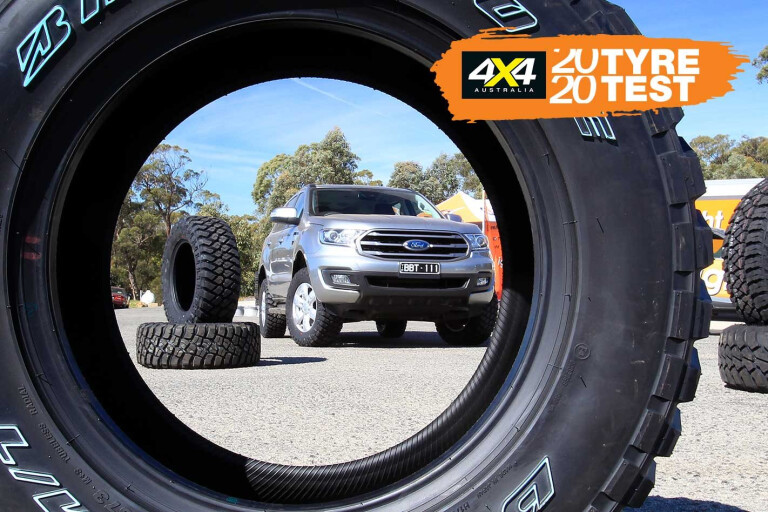
Here at 4X4 Australia we love a good chunky set of mud terrain tyres as much as the next trucked-up wagon. They are, after all, the final piece of the rough-road puzzle for helping that modified rig get to where you want it to go.
But what compromises are you making along the way? What do you give up in grip, noise, cornering precision and comfort by opting for the chunkier black round things that promise to keep on going over just about any terrain? It was that thought that had us assembled at the new Pheasant Wood Circuit south of Sydney on a crisp spring morning.
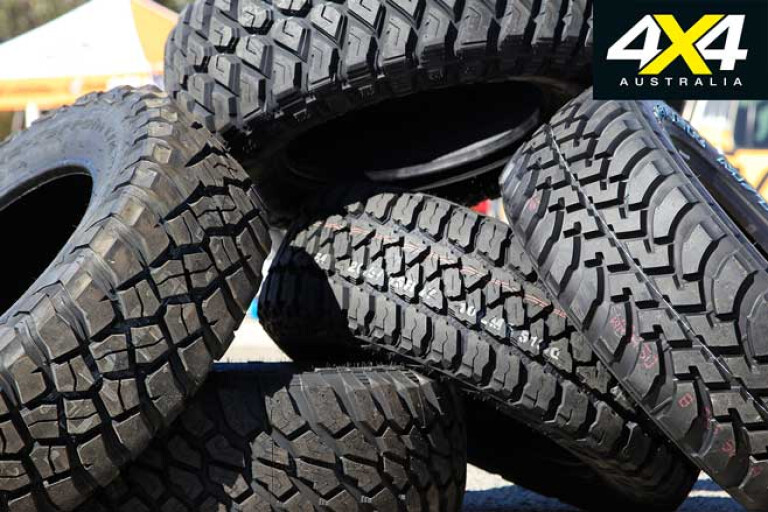
After an appropriate caffeine injection, our colleagues at Tyreright were unpacking a truck and assembling piles of shiny new black tyres – each one ready to be punished through a selection of disciplines.
For this tyre test we’ve gone for mud terrains; the most serious of the off-road tyres for the most serious adventurer. Chunky tread and tough constructions make them a terrific choice for those heading off road. All tyres tested had a light truck (LT) construction with a tougher sidewall for additional off-road protection, albeit often at the expense of comfort and steering response.
As with all tyre designs, any benefits can be outweighed with drawbacks. It’s those negatives we want to learn more about during this exhaustive test.
4x4 Tyre Test 2020: Testing Methods
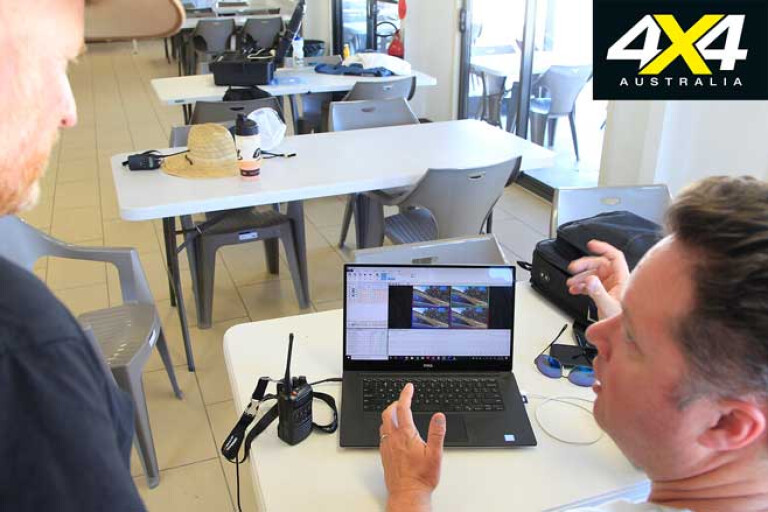
Testing was conducted at Pheasant Wood Circuit south of Sydney using a stock Ford Everest. We chose the base model for its 17-inch wheels, which provided access to a common 265/65R17 tyre size. All testing was conducted on tyres inflated to placard pressures by Paul Stokell, a former Australian Drivers’ Champion and accomplished racer who knows how to push a car to the limit. The car’s stability control was then switched off to allow the car to be tested on the limits of the tyres, rather than having electronics artificially create earlier limits.
Because differences are often measured in centimetres or fractions of a second it was down to technology to take care of the numbers. Data was collected on a VBox data logger, which uses satellites to measure G-forces, speeds, track positions and angles.
Each tyre was put through wet and dry braking assessments, whereby the car is on maximum braking from 100km/h to a standstill. We then conducted three dry cornering tests and two wet cornering tests, evaluating how long it took the car to get through the curve.

For each test the best tyre receives a score out of 100, with the best getting the maximum score and others ranked according to how far they were from the winner. In some cases there were only a few points between best and worst.
The price of each tyre also factors into our rankings, though with a score out of 10 points to account for the big differences between cheapest and most expensive.
The Grunt Work

While the numbers are crunched on the track, it’s in the pits where the grunt work happens. Our crew was from tyre retailer Tyreright, part of an independent network of more than 70 dealers covering all states and territories. Rather than being aligned to a particular brand, Tyreright offers a range of tyres at competitive prices. It also has a large online presence, with an ordering system that allows you to do all but the fitment itself. And with a price guarantee it provides reassurance you’re getting a good deal.
They also do wonderfully quick tyre changes, with the time between our Everest rolling in on worn tyres and rolling back out on the track on fresh rubber measured in minutes. The lads then used the wheels off our spare car to fit and balance the next set of tyres while the action was going on out on the track.
Put simply, the test couldn’t have happened without the Tyreright crew.
Why we didn't test off road
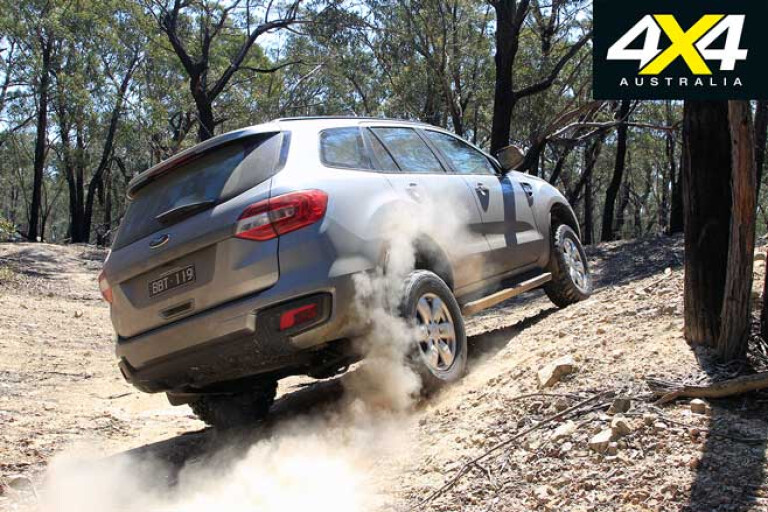
Mud-terrain tyres are designed to go off road, so you may be thinking we’ve lost our marbles in not testing the very thing they’re going to do plenty of. Basically, it comes down to the old argument of no two snowflakes are the same. Hear us out…
Off-roading is such a varied definition that encompasses wildly different surfaces, from sand and mud to rocks and grass. It can even include snow.
The logistics of testing one tyre thoroughly across every surface is enormous, especially in a country like Australia. We’d be covering thousands of kilometres just to adequately represent the varied terrains you can experience in our wide brown land.

Then there’s the challenge of replicating the testing over those surfaces to collate credible data. Drive over one patch of dirt, for example, and it’ll be compacted and shifted to the point where the next tyre to traverse it will be driving over subtly different ground. That holds true for mud, sand, snow and more. So, while you can certainly learn plenty by covering big kilometres with different tyres, for this test it simply wasn’t feasible.
Besides, most driving that most people will do is on bitumen. Even the most passionate adventurers will roll plenty of hotmix beneath their muddies at some point. And as our tests have shown, it’s the place that mud-terrains are most compromised.
Standard Fare
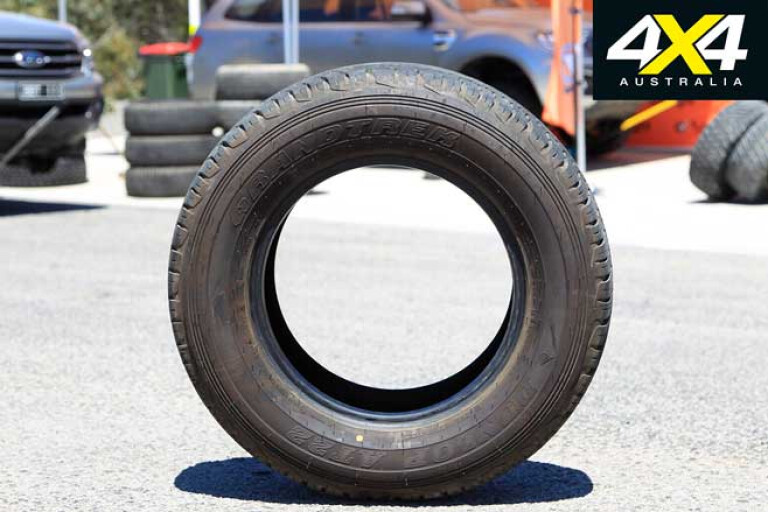
Our two Everests were fitted with Dunlop Grandtrek AT22 rubber. It’s a popular choice also found on various Toyotas, among other brands. They’re an innocuous-looking tyre with a clear emphasis on on-road performance. You get that from the tread depth; there’s just 9.5mm between the outside of the tyre and the inner grooves.
On our mud terrain rivals that steps up to 14 to 15mm, providing more bite and more rubber to protect from punctures. But in the on-road environment we used for this test the Dunlops performed very well, especially in slowing the car in a shorter distance. Emergency stopping distances in the dry were at least 1.5m better than each of our mud-terrains.
In the wet the contrast was more stark. The Dunlop tyres took 47.44m to stop, well ahead of the best of the muddies at 52.51m. Cornering differences were not as pronounced in terms of outright grip, although Stokell noticed they added stability at speed and a predictability on the limit that some of the mud-terrains couldn’t match.
“They’re easy to bring back, too,” noted Stokell when recovering from a slide.
Keep Them Round
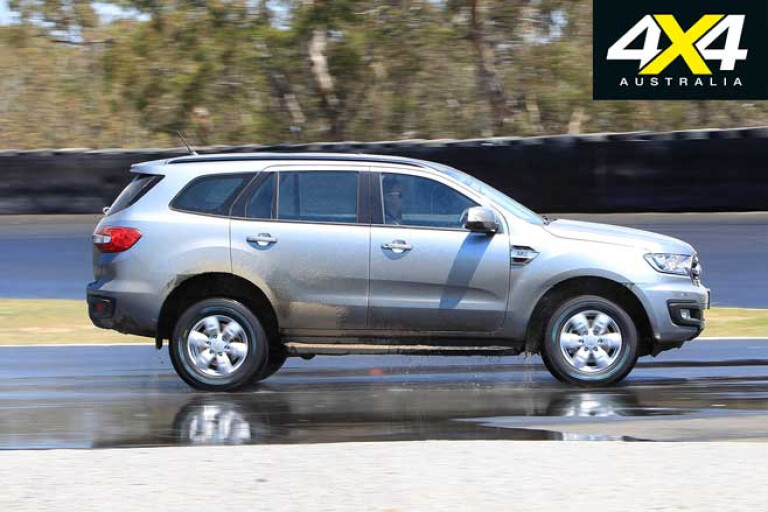
The taller tread blocks of mud-terrain tyres and softer rubber compound make them more susceptible to wearing, especially when driven hard on bitumen.
That’s something we noticed during our track thrashes, as each of the muddies showed visual signs of wear – including feathering and wearing of edges. In comparison, the more road-biased tyres fitted standard to our Everest barely looked driven on, even after warm-up attempts and multiple runs. It’s for that reason Tyreright recommends rotating tyres every 5000km.
“Being a soft compound, mud-terrain tyres will wear out quicker than normal highway tyres,” Tyreright told us.
If you buy your muddies through Tyreright they can be rotated and balanced for free every 5000km, at any one of the 70-plus stores located across the country.
Bridgestone Dueler M/T
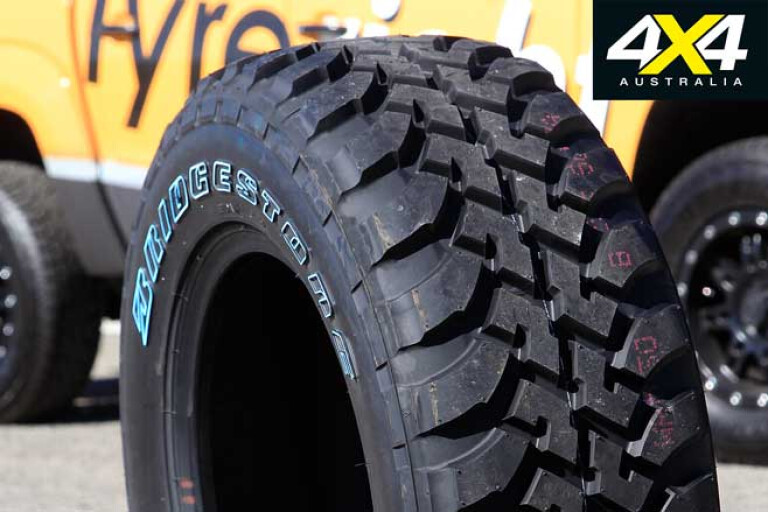
There’s a rugged simplicity about the design of the Japanese-made Bridgestone Dueler M/T. The design is uncomplicated and uncluttered, focusing attention on the chunky tread blocks. “Bridgestone Dueler” writing on the otherwise simple sidewall adds to the visual muscle and the aesthetic reinforcement that these tyres mean business.
Not so easy to digest is the price. At $370 a corner the Bridgestones are the most expensive of the five MTs tested here. Clearly Bridgestone believes the long-running Dueler name is up to the task.
Things certainly got off to a good start, with the Bridgestones stopping shorter than their chunky rivals. At a fraction over 46m in the dry emergency stop they were at least 1.2m better than the rest.
That could be partially attributed to slightly shorter tread depth, so less room for the tread blocks to flex. The Bridgestones had 14mm of tread depth versus 15mm for the BFGoodrich, Kumho and Maxxis tyres. However, that braking prowess didn’t translate to dry cornering, the Duelers hovering around the back of the field.
Similarly, the wet cornering was nothing special, simply on a par with others towards the back of the field. And the braking goodness didn’t translate to a wet road either, the Bridgestones smack in the middle of our five-tyre line-up.
While it wasn’t part of our scoring criteria, something that let the Bridgestones down was noise. There was a noticeable hum at speed, something that set off our noise meter. Stokell also noted that they howl in the wet, adding to the cacophony.
| Dueler M/T Test Results | |
| Dry Braking (100-0km/h) | 46.04m |
| Wet Braking (100-0km/h) | 53.86m |
| Dry Cornering (3 corners - combined) | 16.14sec |
| Wet Cornering (2 corners - combined) | 11.78sec |
| Price | $370 |
Sunwide Huntsman
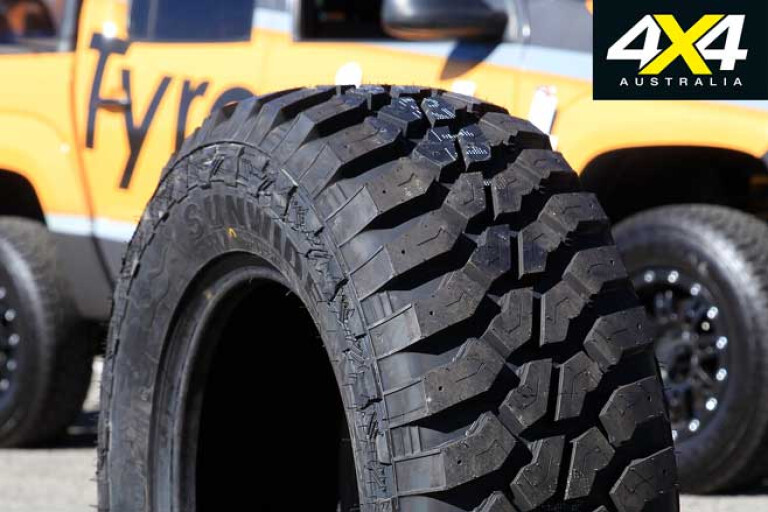
It’s a brand most wouldn’t have heard of, now imported to Australia by our tyre team at Tyreright. To fill you in, Sunwide is produced by Chinese tyre manufacturer Qingdao, which also makes Aventus tyres for trucks.
As with so many things new, the appeal with the Sunwides is their price. At $210 a tyre they undercut their rivals by plenty (between $73 and $160 per corner, which amounts to between $292 and $640 for a set of four). For some, that will be tempting, and it gave the Hunstmans some early points when crunching the numbers.
However, as our testing showed, there are concerns with grip. Slowing the car requires more road with the Huntsmans in place. On a dry road they took between 0.8m and 2.7m longer to stop than their rivals.
With the bitumen darkened by water the Sunwides struggled further, to the point where they took between 2.7m and 5.9m longer to stop. To put it in perspective, the 58m it took to stop left them a full 11m farther up the road than the original Dunlops fitted to the Everest.
The Huntsmans clawed back some cred in dry cornering; although, once the road was wet things were, again, less impressive, with a decent overall score but inconsistent results through each corner.
Test driver Stokell clocked it straight away, saying the Sunwides lacked grip, something also noticeable in our cornering tests. “They let go of traction very early,” he said, adding that “wet-weather grip was lower.”
While we weren’t using traction control, the tendency for the rear to slide into oversteer prompted Stokell to say the Sunwides would keep the ESC busy trying to control any slides.
| Huntsman Test Results | |
| Dry Braking (100-0km/h) | 48.70m |
| Wet Braking (100-0km/h) | 58.45m |
| Dry Cornering (3 corners - combined) | 16.12sec |
| Wet Cornering (2 corners - combined) | 11.76sec |
| Price | $210 |
BFGoodrich Mud-Terrain T/A KM3
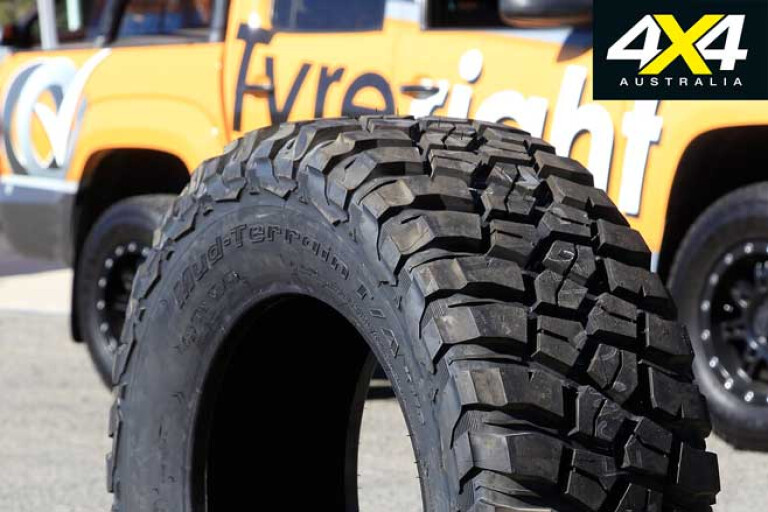
Bolt on a set of BFGoodrichs and it’s almost a statement that you’re not prepared to compromise. They come with a premium price – $350 per hoop – and an even bigger reputation in the bush.
Still owned by Michelin and made in the United States of America, the BFGs have plenty to live up to, especially in M/T KM3 guise. A muscular almost organically shaped tread pattern looks the business, as does the white lettering on the side.
From the outset, though, the BFGs asserted themselves in the middle of the field for on-road grip rather than anything extraordinary. Braking performance in both wet and dry was reasonable without excelling, Stokell noting that braking was their best asset. Similarly, the wet cornering was acceptable and much closer to the pointy end, finishing second only to the Maxxis.
But it was through our trio of dry corners where the BFGs slipped slightly. They were still within the hunt but hovered towards the back of the field in all three corners – just – in what is a critical test.
Our punishment also took its toll on every second tread block, the outer, prouder chunk succumbing to scalloping that suggests you’d want to be on top of rotating them regularly if you’re keen through the corners.
Of course, BFG would argue its MT tyres do their best work off the beaten track, something we don’t doubt. But it wasn’t part of this test.
| Mud-Terrain T/A KM3 Test Results | |
| Dry Braking (100-0km/h) | 47.92m |
| Wet Braking (100-0km/h) | 53.78m |
| Dry Cornering (3 corners - combined) | 16.18sec |
| Wet Cornering (2 corners - combined) | 11.54sec |
| Price | $350 |
Kumho Road Venture MT51

Looks aren’t everything, which is lucky, because the muddies sold by Korean tyre company Kumho don’t have that same unforced masculinity of some rivals. Known as the Road Venture MT51 and manufactured in Vietnam, they’re a value-focused tyre that retails at $283 per corner.
Tread blocks climb subtly down the sidewall, but as with the face of the tyre there’s nothing too aggressive; depending on your taste or purchase criteria, that could be good or bad.
The design does have its benefits, most notably with noise. Our noise meter and Stokell’s ears had the MT51s as the quietest of tyres. There was nothing like the whirring or humming that inflicts so many muddies, the restrained tread instead proving gentler on the bitumen.
The Kumhos also performed well from a grip perspective, leading the MT field in one of the wet and one of the dry corners. That they were close to the money in the rest helped maintain their above-average level. Stokell was also impressed with the progression on the limit, especially with water on the road.
“They’re very predictable in the wet … they let go very controllably.”
It was only in wet braking that the Kumhos were less than impressive, taking a couple of metres longer to stop than most.
One big question mark remained, though, and that was how they would perform off road. That less aggressive tread seems to help on road, but it may not fare as well once rocks and mud enter the equation.
| Road Venture MT51 Test Results | |
| Dry Braking (100-0km/h) | 47.29m |
| Wet Braking (100-0km/h) | 55.79m |
| Dry Cornering (3 corners - combined) | 15.80sec |
| Wet Cornering (2 corners - combined) | 11.84sec |
| Price | $283 |
Maxxis Razr MT
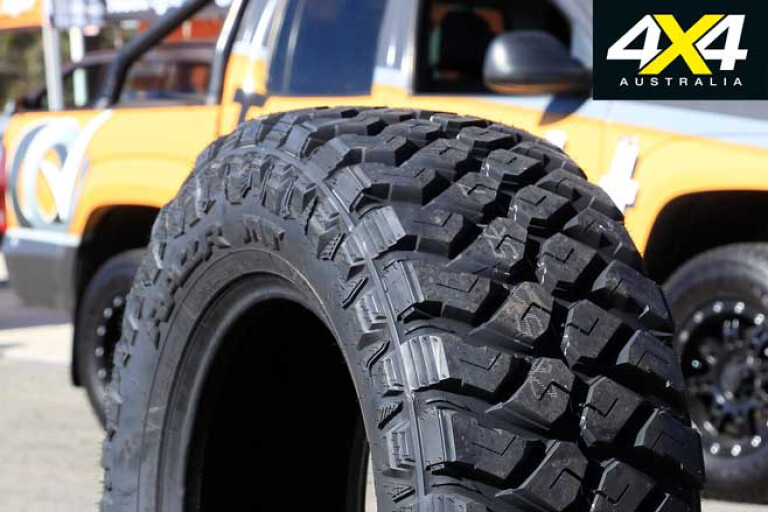
Fresh from a surprise win in our all-terrain tyre test last year, Taiwanese manufacturer Maxxis is arguably better known for its mountain bike tyres than larger ones fitted to cars. Clearly the brand knows what it’s doing, and the Razr MT is the tyre on offer at this end of the market.
From the outset Stokell knew he was driving on tyres that were working better at ground level. The Razr MTs were nowhere near the tyres originally fitted to the Everest for outright grip and poise – road-focused tyres clearly work better on bitumen – but they outclassed their rivals in most disciplines.
It started with wet braking, where the Maxxis stopped at least 1.3m shorter than all rivals. Wet cornering was equally impressive, the Maxxis adding an extra degree of confidence to allow Stokell to push on that fraction harder, in turn scrabbling through the corner better.
If there was one criticism it was in the way it let go approaching the limit. “It certainly let go faster in the wet,” he said.
Even in dry cornering the Razrs were at – or very close to – the pointy end in each of our corners. Total the trio and it was a slim victory around dry corners. Only in dry braking did the Maxxis rubber trail its rivals, outclassed by Bridgestone and Kumho. That the price slotted in the middle of our field, at $305 each, made them all the more impressive.
The Maxxis tyres were also among the best for protecting its outer edges after a solid thrashing, which added some non-scoring goodness to its repertoire.
| Razr MT Test Results | |
| Dry Braking (100-0km/h) | 47.93m |
| Wet Braking (100-0km/h) | 52.51m |
| Dry Cornering (3 corners - combined) | 15.77sec |
| Wet Cornering (2 corners - combined) | 11.28sec |
| Price | $305 |
4x4 Tyre Test 2020: Verdict
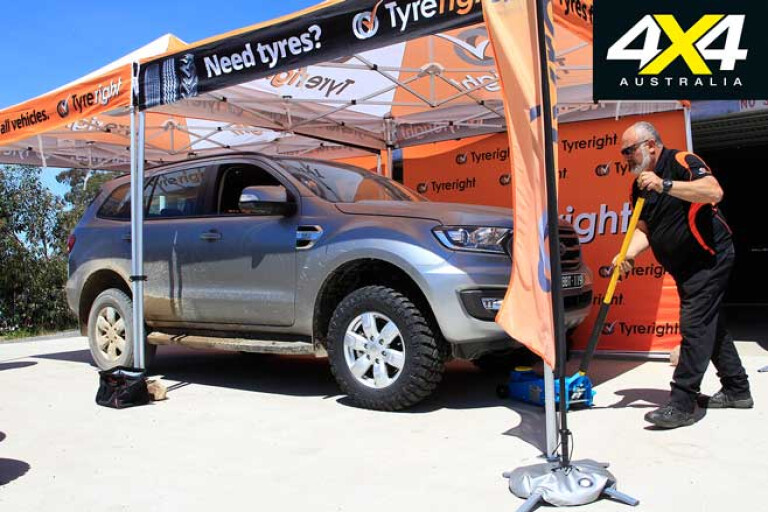
Whichever mud-terrain you choose you’ll be making on-road compromises, and in some instances they’re big compromises that stretch stopping distances or lower the limits of adhesion through corners. The trade-off, of course, is more comfortable and capable off-road touring with less chance of a puncture.
Assuming you’ve made that decision, it’s the Maxxis Razr that performed best in our tests – keeping in mind that we didn’t test the off-road side of the equation. Instead, we focused on which tyres made the least compromises on-road. The decent grip in wet and dry made the Maxxis a solid performer in all disciplines, either leading or doing very well in each category. It was a clear winner, with the sharp pricing helping extend its lead over its quartet of rivals.
Second place went to the Bridgestone Dueler, the most expensive tyre we tested. It was its performance in dry braking that inched it ahead of a tight middle pack. Less impressive was cornering performance, something that only just kept it ahead of hard-charging competitors.
Rounding out the podium was the Kumho Road Venture MT51. While it slipped occasionally in the wet cornering, it regained points through dry bends and dry braking. That the Kumho was respectably quiet was a bonus.
Next was the BFGoodrich KM3s. While it didn’t lead any of our testing disciplines it put up a solid performance in all, albeit at a premium price. If reputation counts for anything, it should back it up with solid off-road performance.
Bringing up the tail in this test is the Sunwide Huntsman. While cornering efforts were respectable, the Huntsman was off the pace with braking – a critical aspect of any off-roader, especially when heavily laden. It was especially noticeable in the wet, where the tyre skated along the wet road metres beyond where others had pulled up.
4x4 Tyre Test 2020: The Data
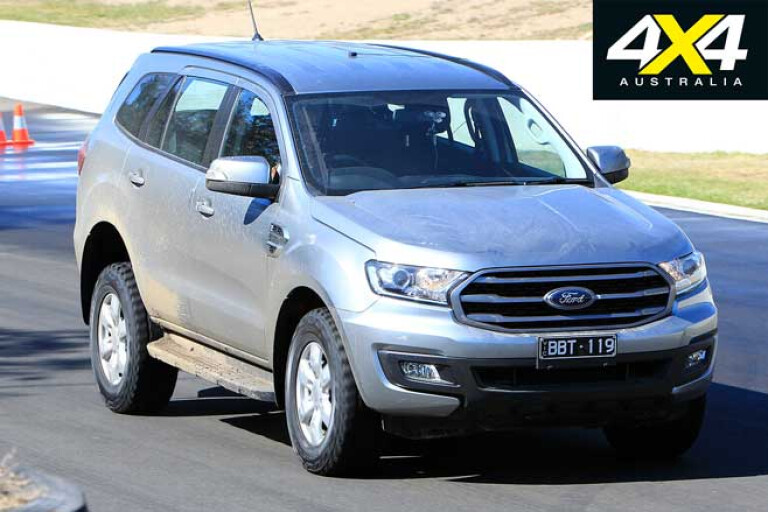
| Dry Braking (100-0km/h) | ||
| 1st | Bridgestone | 46.04m (100 pts) |
| 2nd | Kumho | 47.29m (97.3 pts) |
| 3rd | BFGoodrich | 47.92m (95.9 pts) |
| 4th | Maxxis | 47.93m (95.9 pts) |
| 5th | Sunwide | 48.70m (94.2 pts) |
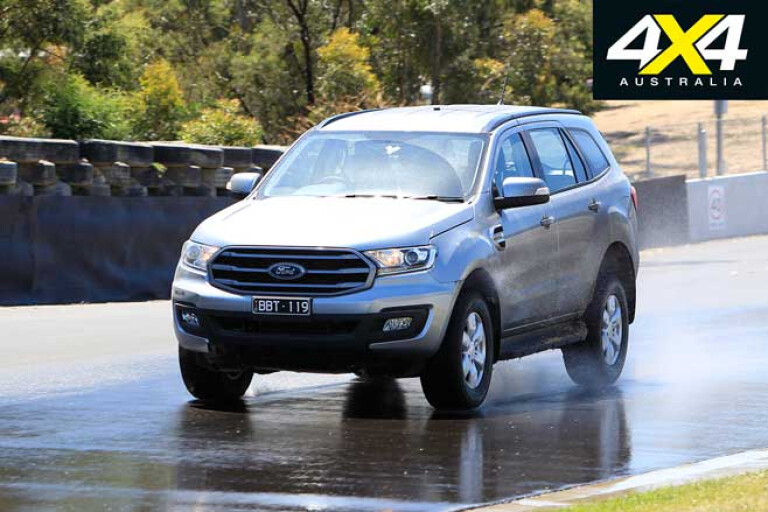
| Wet Braking (100-0km/h) | ||
| 1st | Maxxis | 52.51m (100 pts) |
| 2nd | BFGoodrich | 53.78m (97.6 pts) |
| 3rd | Bridgestone | 53.86m (97.4 pts) |
| 4th | Kumho | 55.79m (93.8 pts) |
| 5th | Sunwide | 58.45m (88.7 pts) |
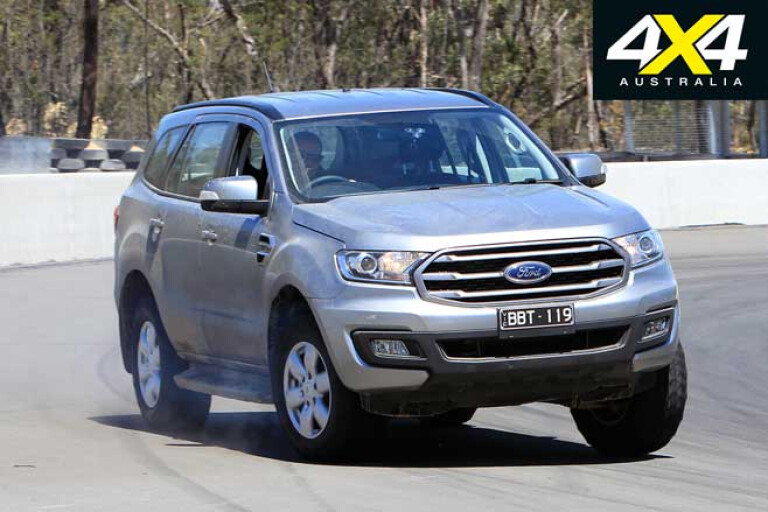
| Dry Cornering (3 corners - combined times) | ||
| 1st | Maxxis | 15.77sec (100 pts) |
| 2nd | Kumho | 15.80sec (99.8 pts) |
| 3rd | Sunwide | 16.12sec (97.8 pts) |
| 4th | Bridgestone | 16.14sec (97.7 pts) |
| 5th | BFGoodrich | 16.18sec (97.4 pts) |
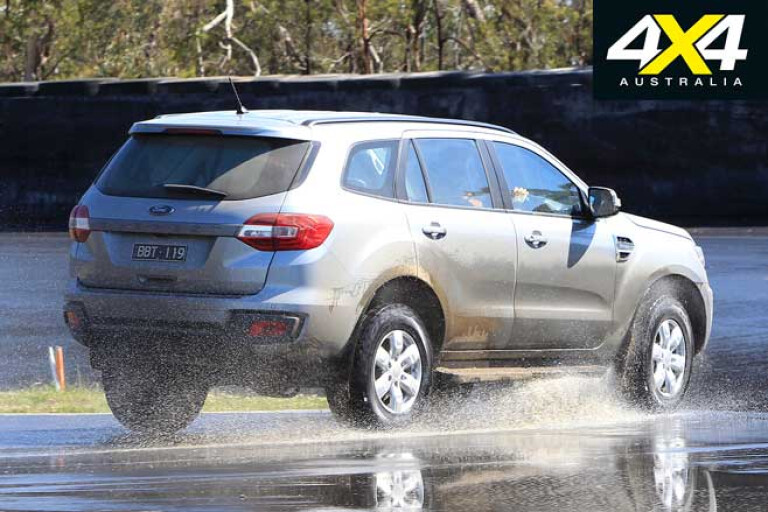
| Wet Cornering (2 corners - combined times) | ||
| 1st | Maxxis | 11.28sec (100 pts) |
| 2nd | BFGoodrich | 11.54sec (97.7 pts) |
| 3rd | Sunwide | 11.76sec (95.7 pts) |
| 4th | Bridgestone | 11.78sec (95.6 pts) |
| 5th | Kumho | 11.84sec (95.0 pts) |
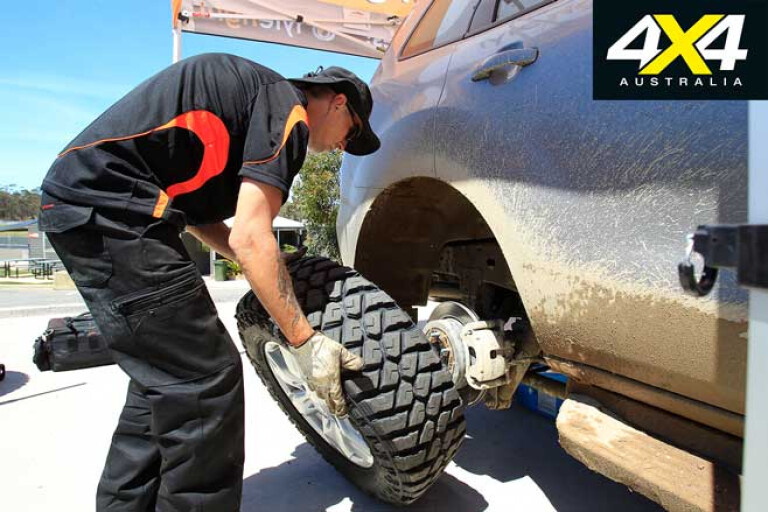
| Price | ||
| 1st | Sunwide | $210 (10 pts) |
| 2nd | Kumho | $283 (6.5 pts) |
| 3rd | Maxxis | $305 (5.5 pts) |
| 4th | BFGoodrich | $350 (3.3 pts) |
| 5th | Bridgestone | $370 (2.4 pts) |
*Point scores are rounded to the nearest 10th for brevity. But for the final points total we included all decimal places; in some instances the totals of the rounded individual scores may differ slightly from the actual total score. Prices are RRP and supplied by Tyreright.
4x4 Tyre Test 2020: The Final Results
| 1st | Maxxis | 401.4 points |
| 2nd | Bridgestone | 393.0 points |
| 3rd | Kumho | 392.4 points |
| 4th | BFGoodrich | 391.9 points |
| 5th | BSunwide | 386.4 points |

COMMENTS